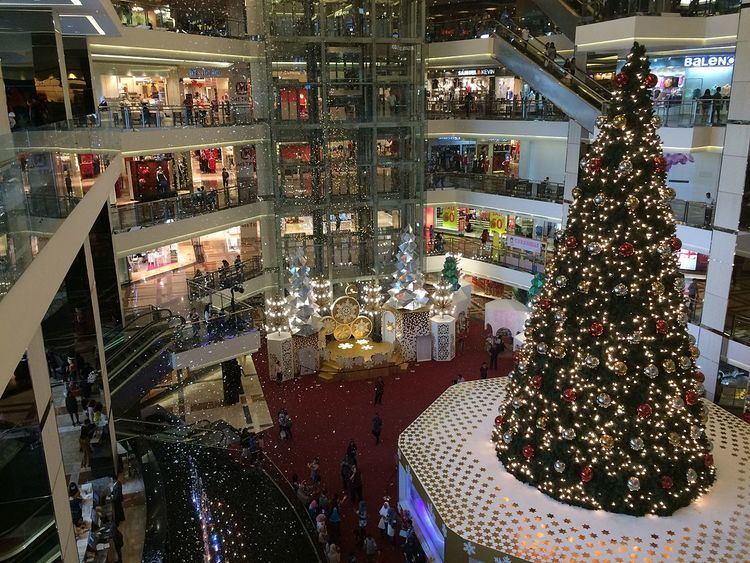 | ||
Christmas in Indonesia (locally known as Natal, from the Portuguese word for Christmas), which has approximately 25 million Christians (of which about 30% are Roman Catholics), is celebrated with various traditions throughout the country. In the regions with a majority of Christians (Protestants and Catholics), there are Christmas celebrations with ceremonies and local food. In big cities, the shopping centres are mostly decorated with plastic Christmas trees and Sinterklas (derived from the Dutch word Sinterklaas). Most local television channels broadcast Christmas musical concerts and the annual, national Christmas celebration which is organised by the government. In addition to traditional foods, generally every Christmas Day is filled with cookies, like nastar (pineapple tart), kastengel (from Dutch word kaasstengel), or 'putri salju'.
Contents
Papua
In the Papua region, after the Christmas mass, a Barapen (grilling stone) will be held, which is a ritual cooking of pork for the feast. The pork meat will be cooked in-between hot stones which are heated using wood. Instead of using matches, Papuan people will scrape the wood continuously to produce heat to set it on fire. In order to prepare the Barapen, the Papuan men will dig a hole to put the hot stones in. At the same time, Papuan women will prepare the vegetables, such as sweet potato, water spinach, fern, cassava, spinach, and papaya. At first, the hot stones are stacked on the base of the hole. Then, the pork and vegetables will be put into the hole, and covered with another layer of hot stones. The three stacks of this arrangement will cook the pork in the hole for half a day. The tradition of Barapen is an expression of gratitude, togetherness, sharing, and love which is characterised by eating pork together.
Ambon
Particularly in Negeri Naku, South Leitimur, Ambon, there is a ceremony called cuci negeri (cleaning the nation). This ceremony symbolises the purification and liberation of sins from the local people and their environment. The cuci negeri is started with a gathering in the community function hall for each clan to hold their own traditional ritual. From there, the Ambonese will walk to the traditional function hall. They do not walk in silence, but sing and dance along with the sounds of tifa (traditional music instrument). Along the way, the women bring some offerings like betel, areca nut, and traditional drink called sopi. Another unique characteristic of Christmas celebration in the Maluku is that the ship sirens will sound and church bells will be rung at the same time on Christmas Eve.
Yogyakarta
In Yogyakarta area, the Christmas celebration is filled with wayang kulit performance about the birth of Jesus Christ. The church mass is led by the priest wearing traditional Javanese costume (wearing beskap and blankon) and using the local language. Similarly with Eid celebration, the Christmas time is used to visit friends and family. Some of the kids in Yogyakarta can also get money in an envelope from the elders.
Manado
The pre-Christmas celebrations in Manado start from December 1 when the regional government officers go on the "Christmas Safari" — observe the mass in a different district every day. Some people in Manado have a tradition to join a carnival or visit and clean their families' graves. The series of Christmas celebrations will be ended in the first week of January with a festival called kunci taon. In this festival, there will be a carnival across the region in unique costumes.
Bali
Most of Christian villages in Bali are located on the south of this island. In those villages, road decorations called penjor (made from yellow coconut leaves) will be made for Christmas, which symbolises Anantaboga dragon. The Christmas celebration is affected by Hinduism — Balinese culture.
In Bali, the Christmas tree is made from chicken feathers. This unique tree has been imported to some European countries.
Toraja
Torajan people celebrate Christmas by having a cultural festival called Lovely December. This festival consists of mass dancing, a culinary festival, cultural carnival, bamboo music performance, and handicraft exhibition. The festival is ended by fireworks and Lettoan procession which is held on December 26. Lettoan is a ritual of having pig parade with cultural symbols that represent three dimensions of human life. Those three symbols are:
North Sumatera
For the Bataknese in North Sumatera, the Christmas Day is always followed by sacrificing an animal as a result of people chipping in and saving the money months before. This tradition is called marbinda and shows togetherness and mutual cooperation. The sacrificed animal can be a pig, a buffalo, or an ox, and the meat will be shared to all the people that participate in the purchasing of the animal.
